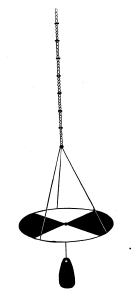Portions of the text below have been excerpted from the following NALMS publications:
Carlson, R.E. 1995. The Secchi disk and the volunteer monitor. LakeLine. 15(1): 28-29, 35-37.
Carlson, R.E. and J. Simpson. 1996. A Coordinator’s Guide to Volunteer Lake Monitoring Methods. North American Lake Management Society. 96 pp.
Carlson, R.E. 1997. The Secchi disk in black and white. LakeLine. 17: 14-15, 58-59.
The original “Secchi’s” disk was all-white. Today most disks used in lakes have alternating black and white quadrants, while marine disks are usually all-white. The reasons for the difference is not clear, and may be more historical than theoretical. Early disks of the 19th century were all white, but George C. Whipple (1899) stated that a disk with alternating black and white quadrants was more easily seen (Fig. 1), and “Whipple’s” disk became the standard in freshwater situations.
In theory, the Secchi disk works as a contrast instrument. It disappears when the human eye can no longer see it, meaning that there no longer remains any contrast between the disk and its background. A white disk should remain visible longest if viewed against a completely black background. In many lakes, the background is less than totally black because the light is reflected off the bottom or back-scattered from suspended particles. In these situations, a white disk may disappear sooner than would be expected than if the background were black. The black quadrants may serve as a constant black background, thus standardizing the contrast. It may be that the all-white disk used in the ocean is acceptable because the background color in the deep ocean is black, thus making the black quadrants unnecessary.
The newest trend in disk color is the all-black disk (Davies-Colley 1988). Developed and used extensively in New Zealand, the disk has the advantage that it can be used in shallow rivers and streams. Unlike the horizontally-held Secchi disk, the black disk is held vertically and is viewed over a horizontal distance using an inverted periscope. Because the black disk does not require much water depth, it can be used in streams. The ability to use black disks in rivers and streams could establish cooperation and compatible data with stream volunteer programs. Lake monitors could use the black disk to discover which streams entering a lake are the most turbid.
Literature Cited
Davies-Colley, R.J. 1988. Measuring water clarity with a black disk. Limnol. and Oceanogr. 33:
616-623.
Whipple, G.C. 1899, 1910, 1914, 1933. The Microscopy of Drinking Water. John Wiley and Sons. New York and London.
Carlson, R.E. 1997. The Secchi disk in black and white. LakeLine. 17: 14-15, 58-59.


